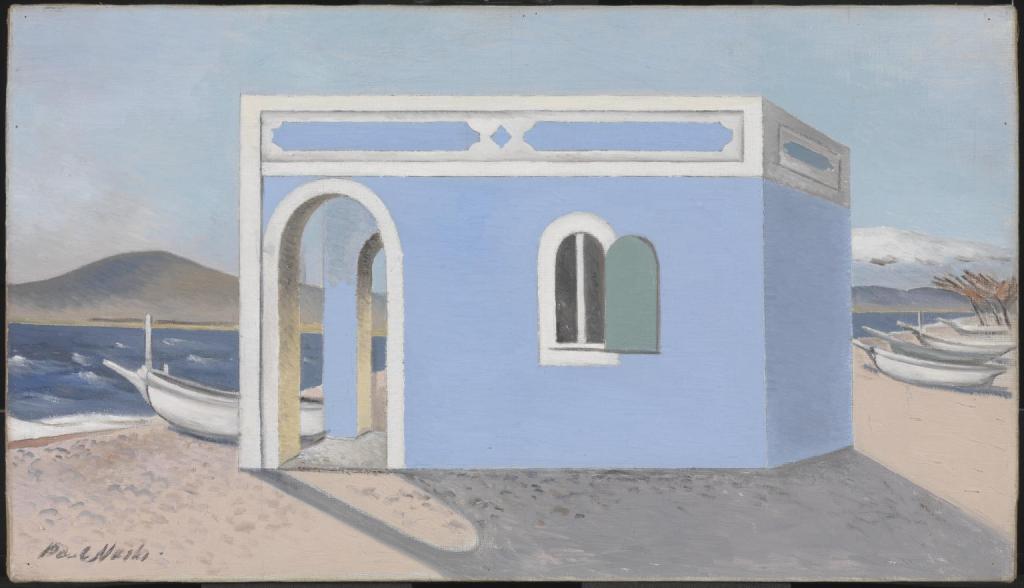In many ways, the Surrealist movement of the early twentieth century can be seen as a development of Symbolism. Both were primarily driven by the literary world – the first Symbolist Manifesto didn’t even consider visual art, which remained controversial – and both were strongly opposed to mimesis, faithful depiction of the physical world.
Surrealism as a revolutionary movement started at the end of the First World War, and gathered both momentum and pace during the 1920s. Because most of its major works are still covered by copyright (as the artists died less than seventy years ago), it’s not an easy subject to cover without negotiating rights to use images. However, there are a few Surrealists whose copyrights have now expired: by far the most important of these is the British artist Paul Nash (1892–1946). Nash was one of the key figures in British Surrealism, and in this article and the next, I’m going to look at his work during the decade starting in 1929, before his work was engulfed by the influence of the Second World War.
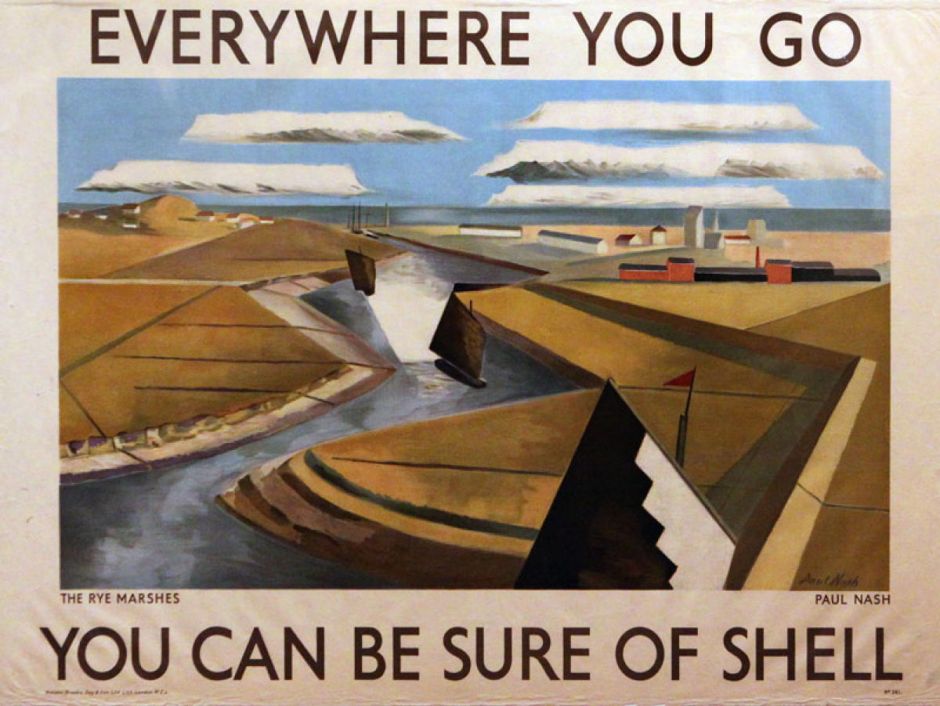
From his earliest works, Paul Nash had particular interest in geometric forms in the landscape, as shown in his painting of Rye Marshes (before 1932) featured in this 1932 advertising poster for the petroleum producer Shell.

This developed into this innovative view from his studio in Sussex, England, Landscape at Iden from 1929. The barren fruit trees are a reminder of his Cherry Orchard from twelve years earlier. They are set in the middle of an odd, faintly surrealist, collection of objects.
A pile of logs for firewood looks as if it has reversed perspective and great foreshortening of the logs. The grass forms a flat plane, uniform in colour and devoid of texture. Two purposeless panels frame the view and exaggerate the perspective, while in the distance is a bank of hills which look almost flat. In the middle of the foreground, a smooth woodbasket containing logs looks completely out of place.
This has been read as a statement of mourning, in which the symbolism of the pile of logs as an altar, and those logs as the remains of fallen trees, could be central.
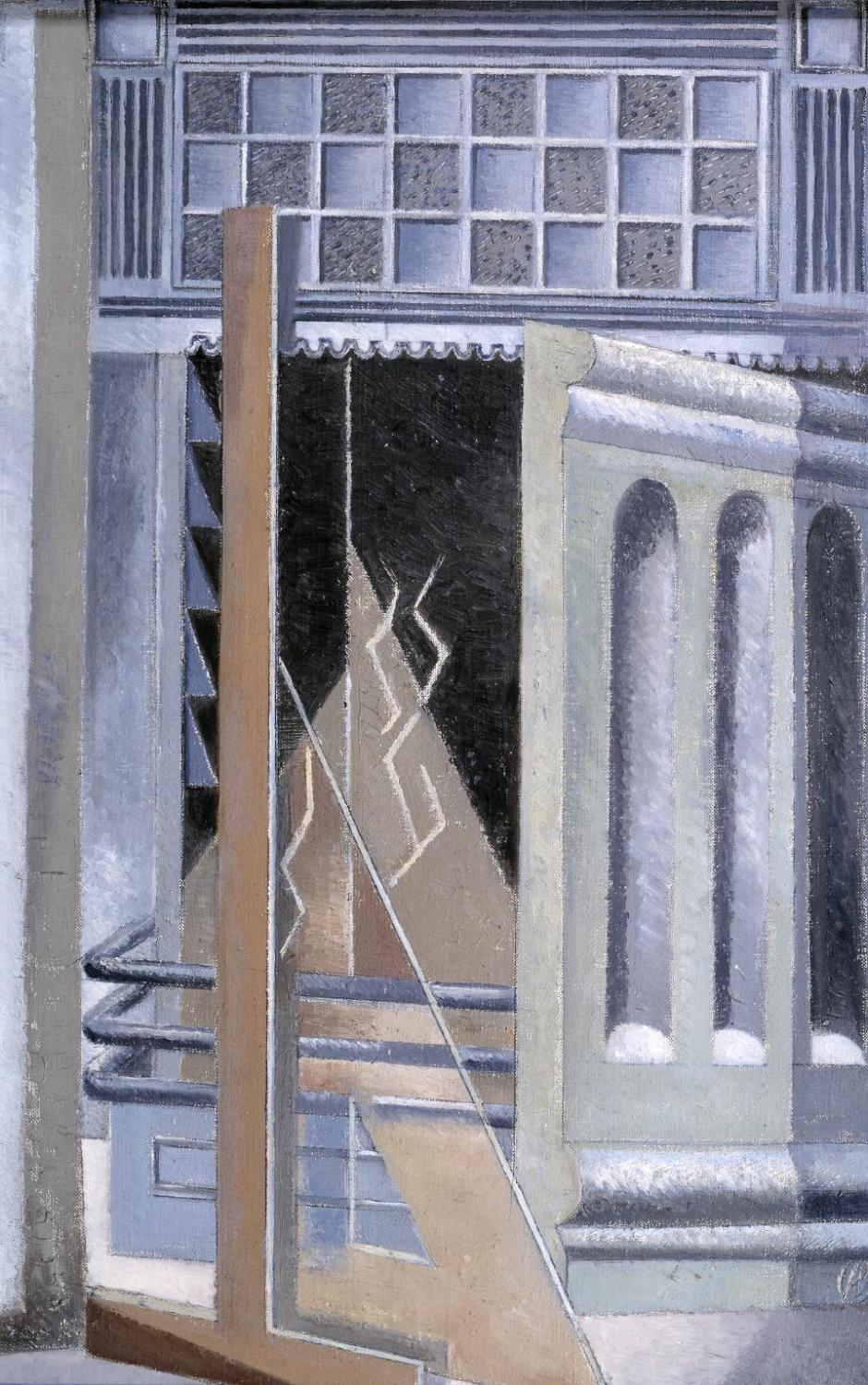
Nash’s Lares (1929-30) takes geometric abstraction even further. Its title refers to the Roman protective deities most characteristically associated with roads and crossroads, but often confounded with household deities associated with the hearth. The painting is based on Nash’s fireplace, within which flames have been represented as thin upward zig-zags. Upward-pointing triangles of the fire are associated with drawing instruments (a T-square and set-square) in the foreground, which would otherwise be completely out of place.
Nash had seen the work of Giorgio de Chirico at the first exhibition of his work in London in 1928, and this probably motivated him towards this type of surreal composition.

In his Nest of the Siren (1930), Nash again brings the incongruous together in one of his early overtly Surrealist works. The painting is framed by brightly-painted walls with pillared decorations, perhaps ornate wainscot panelling. In the middle of these is what might be a painting, but also seems to be a three-dimensional plant trough containing sinuous shrubs. In the middle of those is a small nest, like an acorn cup.
Standing in front of this is a structure resembling a weather-vane, mounted on a turned wooden shaft. At the weather end of the vane is the faceless figure of a Siren; the leeward end appears purely decorative. Three red rods appear to have detached themselves from the walling, two protruding from the plant trough, the third resting on the floor.
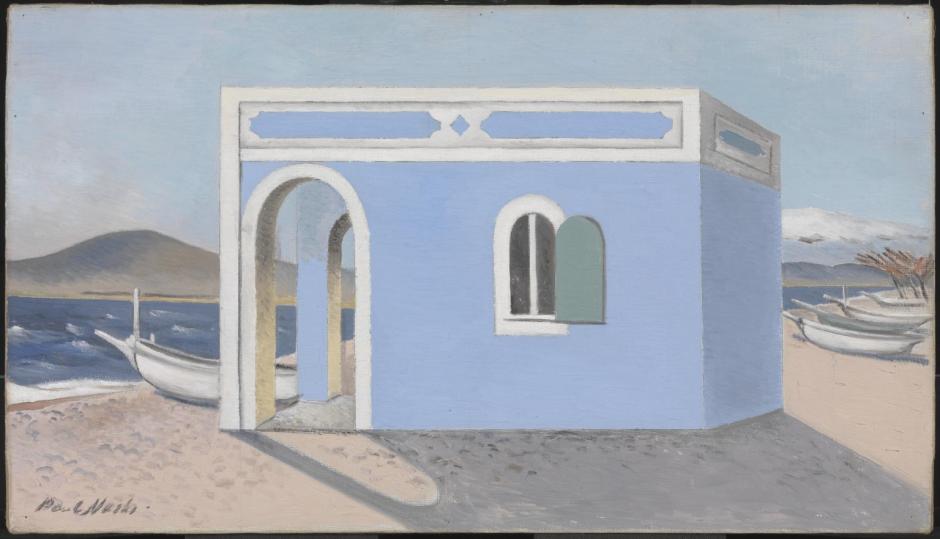
Blue House on the Shore (c 1930-31) is set on the French Mediterranean coast, which Nash had visited around 1927 and again in 1930. It explores the surrealist principle of incongruity, in placing a simple blue building, with contradictory perspective, on a sandy Riviera beach, among fishing boats.

Whiteleaf Cross (1931) may appear unreal, but is quite an accurate depiction of a cruciform hill-carving in Whiteleaf Hill near Princes Risborough in Buckinghamshire, not far from Nash’s old family home. On a down set between small woods, a chalk escarpment has been cut with a trench, which extends to the symbol of a cross above. It is late autumn, with trees devoid of leaves, or their foliage a deep brown.

Nash’s watercolour Mansions of the Dead from 1932 is an illustration for an obscure and mystical essay titled Urne Buriall (1658), by Sir Thomas Browne, which concerns itself with death and immortality. Nash also made a second version which was shown at the International Surrealist Exhibition four years later.
Nash described this painting as showing “aerial habitations where the soul like a bird or some such aerial creature roamed at will”. In addition to those ‘souls’, there are regular geometric constructions which resemble bookshelves with a spacious and airy hangar above.
In 1933, Nash co-founded the Unit One art movement, which started to breathe life back into art in Britain before the Second World War. He also exhibited at the inaugural exhibition of the Mayor Gallery, in London’s Cork Street, alongside the works of Jean Arp, Joan Miró, Georges Braque, Max Ernst, Paul Klee, and Pablo Picasso.
Although it lasted little more than a year, from January 1933 to late 1934, the formation of Unit One was a defining moment both in Surrealism in Britain and more generally in modern British art. Nash and the sculptor Henry Moore were its movers, and other early members included John Armstrong, Edward Burra, Ben Nicholson, John Selby Bigge, and Henry Wadsworth. Also involved were the architect Wells Coates, sculptor Barbara Hepworth, and the New Zealand painter Frances Hodgkins. The last of these resigned shortly after joining, and she was replaced by Tristram Hillier.
The exhibition at the Mayor Gallery was savaged by the critics, who suggested that the works exhibited were practical jokes. The only other gallery in London which was bold enough to show such radical works was the Zwemmer Gallery, which in 1934 exhibited some work by Salvador Dalí.
In the summer of 1933, Nash visited the neolithic landscapes of Silbury Hill and Avebury, in Wiltshire, England, whose magic and sinister beauty were to influence several of his works.
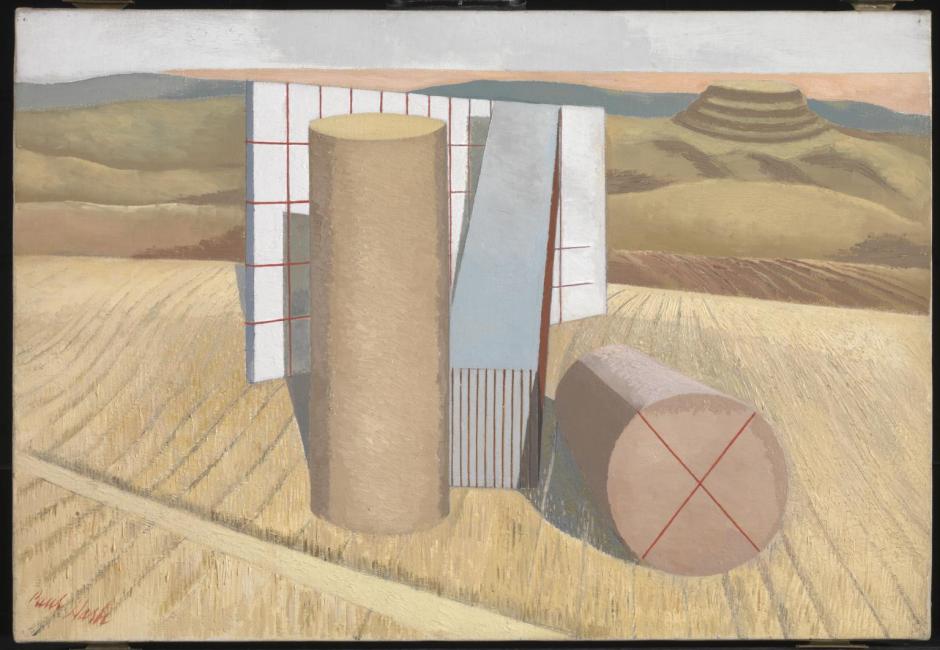
Equivalents for the Megaliths (1935) was inspired by the neolithic landscapes of Wiltshire, here the massive standing stones of Avebury in particular. Nash provides rolling downs and ripe grainfields as the basis for this painting. In the distance is a geometric representation of Silbury Hill, and in the foreground are clean and precise modern solids, the more recent equivalents, perhaps, of the standing stones which they appear to have replaced.
In the late autumn, the Nashes went to London, then on a long trip through France to Gibraltar and North Africa. They returned to England the following summer, living in a cottage on the coast of Dorset near Swanage. Paul Nash was promptly invited by John Betjeman to write a guide to Dorset for the popular Shell Guide series. That was published just over a year later, in 1936, the year that he took part in the first International Surrealist Exhibition in London, which marks the start of the next article about him.
References
Wikipedia – an excellent and detailed account.
Chambers, Emma (ed) (2016) Paul Nash, Tate Publishing. ISBN 978 1 84976 491 9.
Remy, Michel (1999) Surrealism in Britain, Ashgate. ISBN 978 1 859 28282 3.

